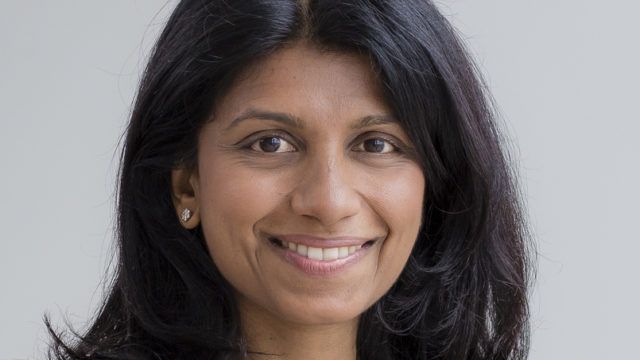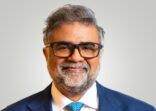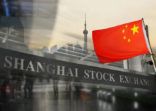So-called disruptive technology themes still seem to resonate among fund houses, despite the spate of fixed maturity products launched this year and while several strategists recommend making tactical allocations to dull-but-safe US government bonds.
Perhaps the threat of global recession and the persistence of the Sino-US trade dispute can be reduced to mere hiccups within the context of the long-term commercial and societal transformations promised by new and evolving technologies.
“Disruption” is the premise guiding the investment strategies of three large, seasoned Pictet Asset Management funds authorised for sale to retail and professional investors in Hong Kong and to accredited investors in Singapore, Anjali Bastianpillai, senior product specialist for thematic equities at the Geneva-based firm told FSA during a two-week visit to Asia.
The investment process for the three Ucits funds — named Security, Digital and Robotics — is the same. The investible universes are narrowed down to 200-400 companies, and a key determinant for final portfolio selection is a company’s “purity” factor.
“At least 20% of a company’s earnings must be derived from the sales of a product or service related to the fund’s theme to be considered. In practice, the funds’ individual holdings all have between 60% and 80% purity factors,” said Bastianpillai.
The three funds have separate managers, and perhaps surprisingly, there is very little commonality across the three portfolios.
The $4.8bn security fund, which was launched in 2006, invests in companies whose specialities range from video surveillance to hazardous waste management, payment processing, cybersecurity and food safety.
“They cover personal and commercial safety, as well as government security,” said Bastianpillai, who stressed that “controversial weapons and offensive military contracting companies” are excluded.
The $3.16bn digital fund, launched two years later, focuses on companies engaged in artificial intelligence, the cloud, 5G and blockchain.
“There is no clean blockchain play for investors — and that includes cryptocurrencies, which are a separate category altogether. Instead, the [digital] fund has exposure to blockchain through investments in companies such as Microsoft and Alibaba that are building monetising apps,” said Bastianpillai.
The $5.14bn robotics fund, launched in 2015, invests in “the entire value chain of [robotic] enabling technologies according to Bastianpillai. These include traditional industrial automated machines, software manufacturers, semiconductors and artificial intelligence firms.
“The ability to invest in enabling technologies is a key differentiator for the fund,” claimed Bastianpillai.
The average portfolio weightings of individual holdings across the three funds are between 2% and 3%, and the biggest weightings in the security, digital and robotics funds are 5%, 4% and 6% respectively.
Bastianpillai agreed that due-diligence is especially vital in areas where complex technologies can sometimes confuse, delude and entrap the unwary. She said that each fund has an advisory board made up of technology academics and industry experts to help the Geneva-based stock pickers.
Nevertheless, the digital fund held shares in German payments company Wirecard, whose accounting practices have been subject to recent media scrutiny.
Pictet’s technology funds: top five holdings
| Security | Digital | Robotics |
| Thermo Fisher Scientific | Baidu | Alphabet |
| Global Payments | Verizon | Intel |
| Fiserv | Alibaba | Siemens |
| Equinix | Booking Hldgs | Intuitive Surgical |
| Fidelity National Info | Alphabet | Synopsys |
Source: Pictet Asset Management, 30 September 2019
Performance measures
The best performer of the three funds over three years is also the newest product in Pictet’s technology thematic stable.
The robotics fund has cumulative return of 57.49%, compared with 43.48% for the digital fund and 38.17% for the security fund.
All three funds’ three-year returns exceed their MSCI AC World index benchmark (50.84%), but only the robotics fund has outperformed the average of 27 TMT funds available to Hong Kong and Singapore investors, according to FE Analytics data.
The MSCI AC World index might be considered an unlikely benchmark for funds with disruptive technology themes. Indeed, there is “very little overlap between the three portfolios and the index”, said Bastianpillai.
However, she insisted that the fund managers don’t want to be constrained by a more specific benchmark. In fact, the funds have held up well against most of the possible alternatives — including the MSCI World Telecommunications Services Index (18.68%) — but not compared with the MSCI World Information Technology Index (78.33%) over three years, according to FE Analytics.
Perhaps as expected, the three Pictet funds are also more volatile than the MSCI AC World (11.51%), but the three-year annualised volatilities of the digital fund (14.44%) and the security fund (13.06%) are less than the TMT sector average (15.72%), with the slightly more speculative nature of some of its small-cap holdings inciting greater volatility for the robotics fund (17.10%).
Pictet hopes to find a receptive audience in Asia. There have been several fund launches this year with technology or innovation themes targeted at investors in the region.
These include Value Partners’ Asian Innovation Opportunities Fund, UOB Asset Management’s United Global Innovation Fund, and most recently, Nikko Asset Management’s Ark Disruptive Innovation Fund.
Pictet Digital, Robotics and Security funds vs MSCI AC World index and TMT sector average

Source: FE Analytics. Three-year cumulative returns in US dollars.

















